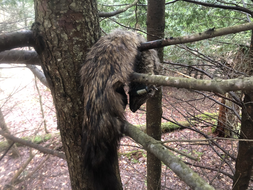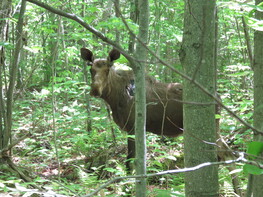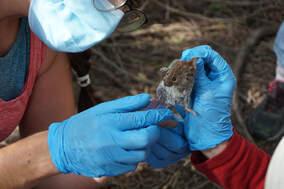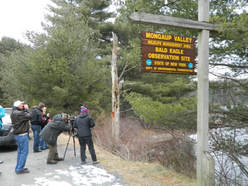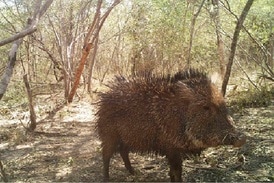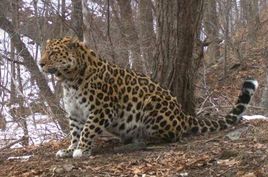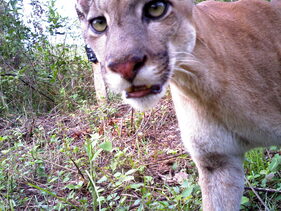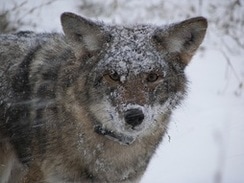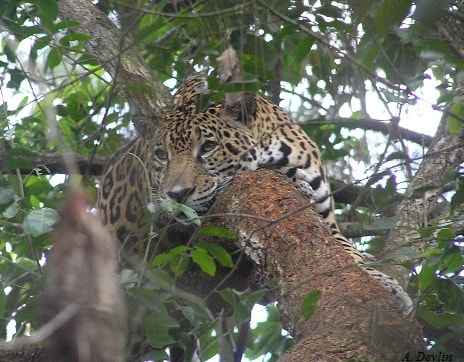Current research
Rodenticide poisoningIngestion of anticoagulant rodenticides is alarmingly widespread among our forest carnivores. Our team is investigating the degree to which AR toxicity may lead to reductions in productivity, survival, or population growth for a suite of native meso-carnivores across northeastern US forests.
Collaborators: Aaron Facka (PA Game Commission), Scott Smith (NY DEC), Lisa Murphy and Julie Ellis (Penn Vet), Beth Buckles and Krysten Schuler (Cornell Wildlife Health Lab), and David Needle (New Hampshire Veterinary Diagnostic Laboratory) Graduate student: Georgianna Silveira (starting fall 2021) Photo credit: Tim Pyszczynski (NYS DEC) |
Moose survivalHaving recolonized the Adirondack Park in recent decades, moose now face a warming climate that threatens their continued persistence along their southern range margin. Our team is assessing the current status of the Adirondack moose population, tracking population trend, and identifying factors limiting population growth.
Collaborators: Krysten Schuler and Angela Fuller (Cornell University), Jeremy Hurst, Jim Stickles, Steve Heerkins, and David Kramer (NYS-DEC), Heidi Kretzer (Wildlife Conservation Society) Current graduate student: Jen Grauer (Cornell) Photo credit: Ben Tabor (NYS DEC) |
NY Mammal SurveyThe first-ever attempt to assess the contemporary status and distribution of every terrestrial and semi-aquatic mammal in NY State. Our team is compiling historical records, verified public sightings, data from recent large-scale survey efforts for meso-carnivores and moose, and conducting targeted field surveys to fill critical gaps on the tiny, rare, and especially cryptic mammals across the state.
Collaborators: NY State Department of Environmental Conservation, NY State Parks, Cornell University Post-doctoral Researchers: Camilo Calderon Acevedo and Josh Twining PhD student: Melanie Berger (bats) |
Past projects
Visit the publications page to see published products from our completed research projects. For work not yet in publication form, graduate theses. progress reports and other relevant links are provided below.
Protected Areas and Biodiversity ConservationDespite billions of dollars being invested in the global network of protected areas as a primary vehicle for biodiversity conservation, the value of protected areas in stemming local species losses or facilitating species range shifts over time is little known. Our team investigated the effect of protected areas on local colonization and extinction rates for 97 avian species across 20 years of climate and land use change across New York and Pennsylvania.
Photo credit: Silvia Saldivar Bellassai
Chacoan PeccaryChacoan peccary are endemic to the
Dry Chaco ecoregion, where they are endangered by habitat loss (deforestation) and overharvest. Our team investigated these threats to Chacoan peccary persistence, as well as assessed the status of their populations, in and around the Defensores Del Chaco National Park, Paraguay. See the results of this study in the M.S. thesis below.
Photo credit: Bob Nixon
Amur tiger & leopardThe Amur leopard numbered as few as 40 individuals in the wild in recent history. The work investigated the forces limiting Amur leopard today, from poaching to competition with Amur tiger, in the Land of the Leopard National Park in Primorsky Krai, Russia to help ensure the persistence of this majestic predator.
Photo credit: Allison Devlin
Large cat conservation
| |||||||||||||||||||||||||||||||||||||||||||||||||
| phd_dissertation_lilian_bonjorne_de_almeida_final.pdf |
Scaling issues in large cat conservation
Identifying effective solutions for large carnivore conservation and conflict resolution requires better understanding of the drivers of habitat use and resource conflict. Our team examined how sensitive research insights may be to the spatio-temporal dimensions of our observations.
| slovikosky_thesis_final.pdf |
Photo credit: Scott Smith
Coyotes
Coyotes colonized NY State in the 1920s and today are the largest and most widespread canine predator around, potentially exerting a large influence on competitor and prey populations. Our team has been investigating coyote foraging ecology, in particular coyote predation on deer and dietary overlap with native mesocarnivores.
|
Chee Peng's thesis investigated the role of coyotes in structuring mesopredator communities in human-dominated landscapes on Fort Drum, NY, using camera traps and GPS-collar data.
| ||
|
Sara Hansen's thesis provided an estimate of the number of coyotes in NY State derived from vocalization surveys linked with distance sampling and sound-spread modeling.
| ||
|
Christina Boser's thesis documented coyote diets and movement patterns in the Agricultural-forest matrix of central NY State.
| ||
|
Scott Warsen's thesis documented the historical trend in coyote diets in the Adirondack Park and provided a comparison of dietary overlap with all other carnivores in the region.
| ||
|
This report provides a comprehensive, cross-study comparison of coyote ecology in NY
| ||
|
Photo credit: Allison Devlin
|
JaguarPersistence of top predators, like the jaguar in Central and South America, is increasingly threatened by expanding human populations and changes in land use. To help guide conservation efforts, our team has studied the spatial and population ecology of jaguar across a gradient of protected areas to cattle ranches in the Brazilian Pantanal, across multiple use landscapes spanning Central America, and within Peru.
|
|
Ana Patricia's thesis focused on assessing effectiveness of putative corridors for jaguar in Guatemala.
Allison Devlin's dissertation focused on the activity, movements, and density of jaguar in the Brazilian Pantanal.
Fatima Sanchez's thesis focused on contributions of protected areas to jaguar conservation in Peru. | ||||
River otter
|
River otter are elusive, slippery, and impossible to tell apart -- so getting a handle on their population status can be tricky. Our team modelled otter habitat suitability, conducted winter track surveys, and deployed field cameras to provide the first comprehensive assessment of otter populations statewide, providing key data for the state's otter management plan.
|
Photo credit: Elaina Burns
| ||||
Fisher demography and rodenticide exposureFisher (Pekania pennanti) occupy northern forests, ranging coast-to-coast across North America. Their populations are rebounding in some areas (e.g, southern portions of their historic range), while others are showing long-term decline. Our team investigated population vital rates and factors potentially limiting fisher within NY State and across the northeastern U.S. to inform effective conservation actions.
|
| ||
